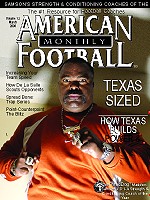AMERICAN FOOTBALL MONTHLY THE #1 RESOURCE FOR FOOTBALL COACHES
Article CategoriesAFM Magazine
|
Samson\'s NFL Strength and Conditioning Coach of the Year: Seattle\'s Mike Clarkby: Steve Silverman© More from this issue Take a look around your living room. If you are an average adult in your 30s, 40s or 50s, chances are a young person is taking up space in your house, sleeping in a bed you provide, eating your food and wearing clothes that you have bought. That young person is likely to be on the couch watching TV or playing video games. The thought of why this young person is inside on a beautiful day giving his opposable thumbs a workout on toggle switches and not playing outside has you shaking your head. If you are worried what all this indoor passive play is doing to the physical condition of young people, you are not alone. Mike Clark, the strength and conditioning coach of the Seattle Seahawks, is concerned about it as well. Not just because he has a health-related positio....The full article can only be seen by subscribers. Subscribe today!
|
|
|||||||
| HOME |
MAGAZINE |
SUBSCRIBE | ONLINE COLUMNISTS | COACHING VIDEOS |
Copyright 2025, AmericanFootballMonthly.com
All Rights Reserved





